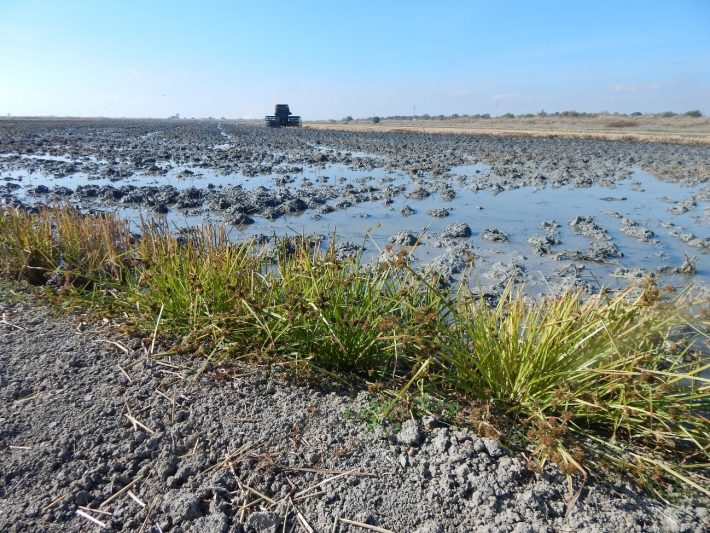Gulls can spread weeds over large distances and between habitats
Doñana Biological Station press release.
A new model published in Journal of Ecology shows that gulls can disperse weeds over large distances and between different habitats, causing the exchange of weed and alien plant species between agricultural crops and natural areas.

A study from the Doñana Biological Station has developed a seed dispersal model based on the movement of gulls monitored by GPS telemetry, while feeding in rice fields in Andalusia, South-West Spain.
Birds can play a major part in the spread of weeds and alien plants. Seeds can be ingested and then expelled elsewhere after gut passage, so these animals can be major dispersers of weed seeds, along with humans, causing great economic losses to farmers. This dispersal may also cause serious ecological problems: some of these weeds may endanger the local biodiversity in natural areas.
Until now, studies of seed dispersal have focused on frugivorous birds, underestimating the role of waterbirds as seed dispersers. In recent years, waterbirds have received more attention”
– explains Dr. Víctor Martín Vélez from the Doñana Biological Station (EBD-CSIC) who studied seed, nutrient and pollutants dispersal by gulls in Andalusia for his PhD, under the supervision of Prof. Andy J. Green and Dr. Marta I. Sánchez.
In this latest study, an international team led by the EBD-CSIC investigated how waterbirds can spread weeds within and between different habitats. Most weeds lack fleshy fruits and have small seeds, not previously thought to disperse via birds. They focused their study on Lesser-Black Backed Gulls (Larus fuscus), a species that has undergone major population growth in Europe, and is now abundant inland in winter in southern Europe.
For the research, 19 gulls from five different breeding colonies in the UK, the Netherlands and Belgium were monitored using GPS between 2010 and 2017, when they were some of the thousands of individual gulls frequenting the ricefields surrounding Doñana in South-West Spain. This gull species is now one of the three most numerous waterbirds wintering in Andalusian wetlands (together with the shoveller and the greater flamingo), so its role in the seed dispersal could be important.
Understanding dispersal patterns can help to manage new, or herbicide resistant, weed species within agricultural systems
– explains Víctor Martín.
The research team used the daily movements, combined with data estimating the retention times of plant seeds in their guts, to develop a plant dispersal model. The model focused on four weeds regularly carried by the gulls: Toad Rush (Juncus bufonius), Small-flowered Nut Sedge (Cyperus difformis), Annual Beard Grass (Polypogon monspeliensis) and the alien Common Amaranth (Amaranthus retroflexus)
The gulls ingest weed seeds together with their main food of alien crayfish and waste rice grains, and results indicate that more than 10,000 seeds were dispersed every day by gulls in the rice fields of Doñana, an area of 370 km2. About 92% of all seeds transported by gulls are dispersed into different rice fields, most of them being moved over distances from 0.5 to 40 km. But where are the remaining 8% of seeds moved to?
Owing to the high mobility of gulls between different places in Andalusia, it was estimated that these remaining seeds were dispersed into other habitats outside the ricefields, up to maximum distances exceeding 150 km. Of these seeds, 42% of them reached other moist environments likely to be suitable for weed establishment, such as other irrigated agricultural areas (e.g. cotton or wheat fields), and protected natural wetlands such as Fuente de Piedra lagoon or Doñana Natural Space. Until now, these weed species were thought unable to disperse over distances exceeding 100 m, except when moved by humans or their machinery.
These results suggest that waterbirds, such as gulls, may be important weed dispersal vectors between human-dominated and natural areas. A better understanding of this role for birds is vital when predicting the spread of weeds, and planning control measures. “This research opens the door to other studies, such as how birds could be contributing to the expansion of herbicide-resistant genes within weed populations” concludes the researcher.
You can read the article here:
Víctor Martín-Vélez et al. Spatial patterns of weed dispersal by wintering gulls within and beyond an agricultural landscape. British Ecological Society. https://doi.org/10.1111/1365-2745.13619
Media contacts:
Victor Martín-Vélez on +34 622143855 // victormartin_velez@hotmail.com
Professor Andy J. Green on +44 754 994 79 76 or +34 699 450 383
Like what we stand for?
Support our mission and help develop the next generation of ecologists by donating to the British Ecological Society.